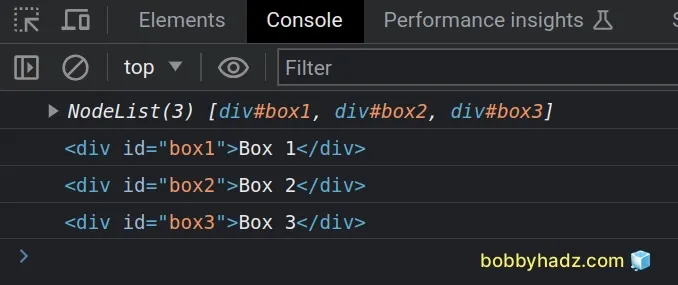Select elements by Multiple IDs using JavaScript
Last updated: Mar 5, 2024
Reading time·2 min

# Select elements by Multiple IDs using JavaScript
Use the querySelectorAll() method to select elements by multiple ids, e.g.
document.querySelectorAll('#box1, #box2, #box3').
The method takes a string containing one or more selectors as a parameter and returns a collection of the matching elements.
Here is the HTML for the examples.
<!DOCTYPE html> <html lang="en"> <head> <title>bobbyhadz.com</title> <meta charset="UTF-8" /> </head> <body> <div id="box1">Box 1</div> <div id="box2">Box 2</div> <div id="box3">Box 3</div> <script src="index.js"></script> </body> </html>
And here is the related JavaScript code.
const boxes = document.querySelectorAll('#box1, #box2, #box3'); // 👇️ [div#box1, div#box2, div#box3] console.log(boxes);

We passed multiple, comma-separated selectors to the
document.querySelectorAll() method to
get a NodeList of the elements with IDs box1, box2 and box3.
If none of the selectors matches an element, an empty NodeList is returned.
SyntaxError exception is thrown.# Select elements using an array of IDs
If you have an array of IDs and need to get a collection of the elements with these IDs, use this approach instead.
const ids = ['box1', 'box2', 'box3']; const boxes = document.querySelectorAll( ids.map(id => `#${id}`).join(', ') ); // 👇️ [div#box1, div#box2, div#box3] console.log(boxes);

The function we passed to the Array.map() method gets called with each ID in the array.
The map() method returns a new array containing the values returned from the
callback function.
The last step is to join the array of IDs into a string with a comma separator.
# Iterating over the NodeList
If you need to iterate over the NodeList, use the
NodeList.forEach()
method.
const boxes = document.querySelectorAll('#box1, #box2, #box3'); // 👇️ [div#box1, div#box2, div#box3] console.log(boxes); boxes.forEach(box => { console.log(box); });

The function we passed to the forEach method gets called for each element in
the NodeList.
Note that you can't use all of the native array methods on the NodeList.
# Converting the NodeList to an array
If you need to perform more complex operations on the collection, use the
Array.from method to convert it to an array.
const boxes = Array.from( document.querySelectorAll('#box1, #box2, #box3') ); // 👇️ [div#box1, div#box2, div#box3] console.log(boxes); // 👇️ true console.log(Array.isArray(boxes));

The Array.from() method takes an array-like object and converts it to an array.
You can also use the spread syntax (...) to convert the NodeList to an array.
const boxes = [...document.querySelectorAll('#box1, #box2, #box3')]; // 👇️ [div#box1, div#box2, div#box3] console.log(boxes); // 👇️ true console.log(Array.isArray(boxes));
The spread syntax (...) unpacks the elements of the NodeList into an array
which enables us to use any array methods on the collection.
# Additional Resources
You can learn more about the related topics by checking out the following tutorials:

